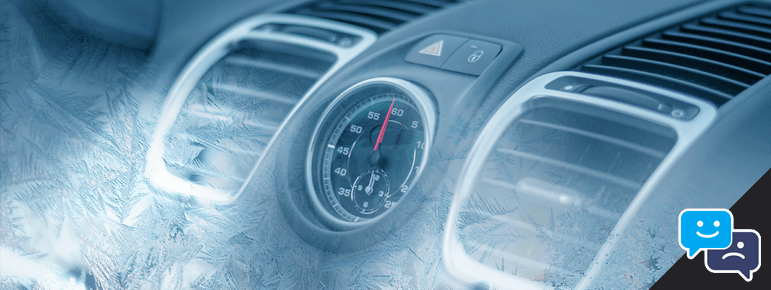A car heater blowing cold air is one of the worst things that can happen on a frosty morning. And there are at least five different issues within your vehicle that can result in such a situation. So, is your car heater blowing cold air? Here’s why.
A broken thermostat, low coolant level, jammed blend door, broken heater controls, or heater core problems might be the reason for your car heater blowing cold air.
If you’ve ever been driving on a cold winter day and turned your car’s heater on expecting to get warm only to find it blowing cold air at you instead – we feel your frustration!
You shouldn’t have to be stuck in a freezing car when all you wanted was some hot air. In this guide, we’ll discuss the possible causes of why your car heater is unexpectedly giving you an arctic chill. Then we will detail what measures can be taken to resolve the issue.
Let’s get into the details about how best to tackle this problem as quickly (and cheaply!) as possible.
Why Is Your Car Heater Blowing Cold Air?
When your car’s heater starts to blow cold air, it can catch you off guard. Sometimes the change happens abruptly, with all the warmth fading away in a second flat.
Other times it’s more gradual — little by little you start to notice that something isn’t quite right with an otherwise dependable source of heat on long car rides.
But no matter when the cold air begins to creep in, one thing remains: getting those chills taken care of as soon as possible.
However, depending on the root cause of the problem, it may be as simple as topping off your coolant. Or, it may require some mechanical attention.
Cleaning the heater core, replacing the thermostat, bad heater controls, or possibly even the blend door may need some attention.
Let’s take a look at each and what you might expect to pay to fix.
Low Coolant Level
Coolant keeps the engine from overheating and acts as a source of heat for the heating system. If the heater is blowing cold air and your temperature warning light has been triggered, then you need to top off your coolant.
Thankfully, a gallon of coolant will only cost you $20-$25. Just make sure you purchase the correct coolant for your car. Some brands, such as Subaru require a specific coolant to be used.
But don’t stress, the best way to determine the required coolant for your vehicle is to check your owners manual.
However, if you take the car to a mechanic, you might have to pay $100-$200 for a coolant change.
But if all you need is a little topping off, skip the mechanic and pick up a gallon of coolant and a funnel. The process of topping off coolant is easy.
Here’s a helpful video on how to check and add coolant.
Broken Thermostat
If your thermostat stays on ‘C’ even after the engine has had enough time to heat up, then the element might have gone bad.
When the thermostat can’t sense that the engine is already warm, the coolant won’t get sent to the heating core. The result is cold air blowing from the heater.
Vehicle thermostats usually last for 8-10 years. However, when they go bad, the only thing you can really do is replace it.
Replacing a thermostat usually requires a trip to the local mechanic. Expect to pay around $150-$500 for this work.
However, if you’re handy, and can do the job yourself, expect to pay between $15-$100 for the replacement thermostat and coolant.
Broken Heater Controls
If no heat is coming out of the heater or you can’t change the settings at all, then the control buttons might be clogged or broken.
If the problem is only the control buttons, then you might be able to find a new control switch knob for about $10-$15. Check your local auto parts store or the dealer for a replacement switch.
One thing to mention is, not all vehicles have a heater control valve. However, the ones that do might stop blowing hot air if the valve goes bad.
On average, you can expect to pay $230 for a replacement heater control valve.
Heater Core Issues
When a heater core goes bad, there are many different symptoms to watch for. The most obvious – your car is using up coolant and there are no leaks. Or, there is a film of fog on the inside of the windshield. You may even notice a sweet smell when the heater is on and blowing air.
These are all signs that there is something wrong with the heater core.
You can manually clean a clogged heater core or flush it for around $80-$90. In some cases, you might have to replace the unit, which can cost you up to $1,000.
Jammed or Bad Blend Door Actuator
The temperature blend door is the element that is responsible for sending air over the heater once you turn it on.
There is something wrong with the blend door actuator if the heater is blowing cold air, there are different temperatures coming out of the driver’s and passenger’s sides, and/or you hear a clicking noise.
It can cost you anywhere between $200 and $500 to get the blend door actuator replaced.
Can a Bad Head Gasket Cause Heater to Blow Cold Air?
Yes, as bad head gasket can coolant loss but also your heater to blow cold air. If you notice your engine is overheating, and triggering the check engine light, it could be a blown head gasket.
As you can imagine, this is much more serious. Air bubbles in the cooling system can cause your heater to blow cold air, but they can do much worse if left unchecked.
Car Heater Blowing Cold Air FAQs
What Does a Clogged Heater Core Sound Like?
If the heater core is blocked, it will create a gurgling sound when you first turn it on. This happens because air gets stuck in the coolant.
Is Antifreeze the Same as Coolant?
Antifreeze and engine coolant are alike, but not identical. Antifreeze is a dense liquid made from glycol that needs to be mixed with water before use, which only then becomes coolant. You can also buy pre-mixed engine coolant, which is a solution of antifreeze and water that is ready-to-use.
Can you Drive with Failing Heater Core?
Using a car with a broken heater core can be dangerous because it may cause overheating and severe damage to the engine. Even a blocked heater core can obstruct the coolant flow and make the engine run hot. However, if you need to drive a short distance, monitor the temperature gauge closely.
What makes a heater core go bad?
There are a few causes for a malfunctioning car heater core. It could be clogged if the coolant isn’t flushed regularly and gets contaminated. Another reason is a leak in the system.
Is Replacing a Heater Core Easy?
The short answer is, no. Because replacing a heater core typically requires removing a lot of interior paneling and duct work, which can be challenging to do on your own.
Alternatively, paying a mechanic to do it can be very costly due to the extensive time needed to take out the required parts to get to the heater core.

Final Thoughts: Car Heater Blowing Cold Air
All in all, not having a working car heater can make for a cold and unpleasant drive with seemingly no way out. But if you narrow down the culprits behind this unfavorable climate change, fixing the issue becomes much more achievable.
Check the coolant level and clean the heater controls. And if that doesn’t help, then it might be better to let the professionals take care of the problem.
Before bringing your car to the shop for what you think is a big problem – check each of these five issues first. You may have already solved your issue in only a few simple steps!
Make sure to properly maintain your vehicle’s vital components and you’ll rarely find yourself without heat on cold mornings ever again. So until that unfortunate day arrives, stay warm and remember to keep those wheels rolling.

Managing Editor
Christopher is an automotive technical writer. When he’s not at the local autocross event, he can often be found working on one of his cars. Specializes in automotive class action law, industry trends, and automotive maintenance. Email me direct, or learn more about us

